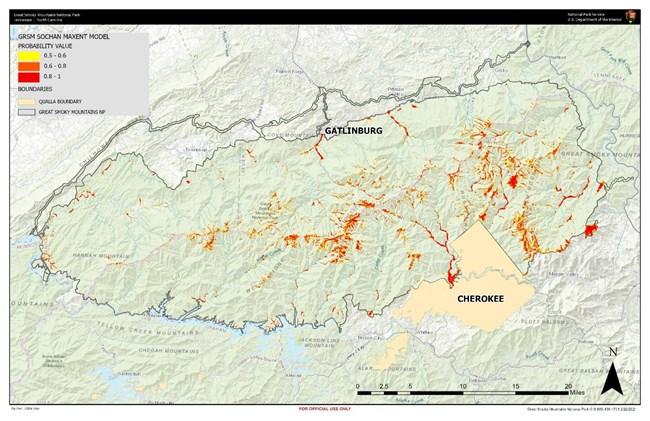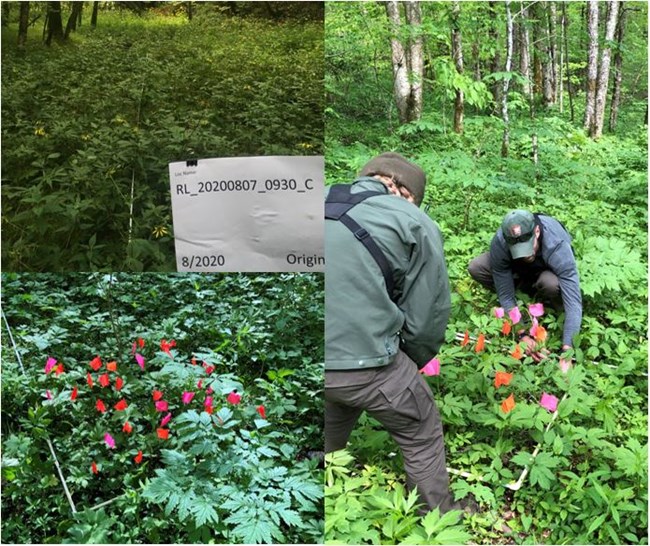Last updated: June 24, 2021
Article
Sochan Gathering for Traditional Purposes in Great Smoky Mountains National Park Resource Brief

NPS Photo
Program History, Description & Conditions
In 2019, following an environmental assessment, public comment period, and a finding of no significant impact (FONSI), Great Smoky Mountains National Park (GRSM) entered into a historic general agreement with the Eastern Band of Cherokee Indians (EBCI) to allow enrolled members of the EBCI to gather sochan (Rudbeckia laciniata) in the park for traditional food purposes. This program is authorized under the 2016 NPS Plant Gathering Rule, Gathering of Certain Plants or Plant Parts by Federally Recognized Indian Tribes for Traditional Purposes (36 CFR 2.6).The EBCI reside within the Qualla Boundary in western North Carolina, adjacent to GRSM along its southern border (Fig. 1). For thousands of years, the Cherokee people gathered plants and plant parts for food purposes using traditional techniques (hand-picking) and knowledge within the southern Appalachians and in the area that is now GRSM. The early spring leaves of sochan plants are an important food source of the Cherokee diet (Fig 2.).
The NPS Plant Gathering Rule provides a framework for implementation of the program. The program allows for up to 36 permits to be issued to EBCI members each season. EBCI members are authorized to harvest from March 1 - May 31 within defined and designated harvest areas across the park (Fig. 1). Permittees attend a joint EBCI/GRSM workshop prior to each harvest season to learn about program specifics, carry a special use permit, utilize specialized harvest bags (Fig. 2) and traditional techniques (hand-picking) to collect sochan leaves, and submit weekly harvest reports to GRSM staff indicating harvest location, quantity harvested, and other details. Permittees are authorized to gather up to 1 bushel (~1200 ounces) of sochan leaves per week during each week of the harvest season for personal consumption.

NPS Photo
Sochan Habitat in Great Smoky Mountains National Park
Sochan is a tall (3’-8’) herbaceous plant that is found mostly in sunny moist areas, stream banks, and mid- to high-elevation seeps through the park. Prior to the start of the harvest program in 2019, GRSM staff collected GPS data on sochan populations throughout the park. These data were then used to develop a habitat distribution model for the park, i.e., a model that predicts where habitat conditions (e.g., moisture, sunlight, terrain) are suitable for sochan plants to grow. Based on the results of this model (Fig. 3), GRSM contains ~7500 acres (~5700 football fields) of suitable sochan habitat (has habitat with conditions with 50% or greater probability of supporting sochan), with approximately one-third of that habitat occurring in designated harvest areas (Fig. 2).
Photo by David Cozzo

NPS Photo
GRSM Monitoring Effort
A primary objective of this program is to allow EBCI members to gather sochan in the park in a manner that helps to sustain an important, long-standing cultural value, while also ensuring the long-term sustainability of the program through monitoring and protection of sochan and its habitat. GRSM staff track harvest reports, perform site visits, conduct annual sampling at sochan monitoring plots across the park to assess for impacts of gathering on sochan populations and habitat, and conduct analysis and reporting on all data collected.Some plots occur within areas that are harvested, while others are excluded from harvesting in order to document natural variability within populations. Each plot consists of a series of randomly located 1x1 meter sample quads arranged along fixed lines (i.e., transects) that span the population from center to outer boundaries. These quads are used to collect data on sochan abundance, vigor (e.g., sochan plant height and flower abundance per sochan plant), and fertility, and to document any natural or human-caused disturbances.
So What? The Importance of the Sochan Gathering Program
The Sochan gathering program is important for several reasons:- The Cherokee people have a well-defined and long-standing history of gathering plants or plant parts for traditional uses throughout the southern Appalachians. The NPS rule, Gathering of Certain Plants or Plant Parts by Federally Recognized Indian Tribes for Traditional Purposes (36 CFR 2.6), has provided a framework for traditional plant or plant part harvesting in GRSM by the EBCI.
- The park’s science-based gathering program could serve as a model for other land management agencies interested in adopting similar programs.
- It helps EBCI members to preserve an important, long-standing cultural value that dates back thousands of years.
- Sochan is an important part of the Cherokee diet and has high nutritional value. A serving of sochan is defined as 100 grams (similar to other greens like spinach or kale). Each serving is high in nutrients like fiber, potassium, folate, and other key nutrients.
- This General Agreement has created a framework for: 1) building a knowledge base and management strategy to support the implementation and permitting of future plant-gathering activities with the EBCI, 2) developing collaborative mechanisms for monitoring plant gathering and removal activities, and 3) expanding outreach to EBCI members and to EBCI and GRSM visitors regarding traditional resource use.
- Improve knowledge and understanding of sochan populations throughout the park.
More Information
Joshua Albritton, e-mail usTom Remaley, e-mail us
Federal Register :: Gathering of Certain Plants or Plant Parts by Federally Recognized Indian Tribes for Traditional Purposes
NPS PEPC - Sochan Gathering for Traditional Purposes FONSI and General Agreement
Sochan Gathering | Cherokee Natural Resources
Cherokee Indians Can Now Harvest Sochan Within a National Park | Science | Smithsonian Magazine
